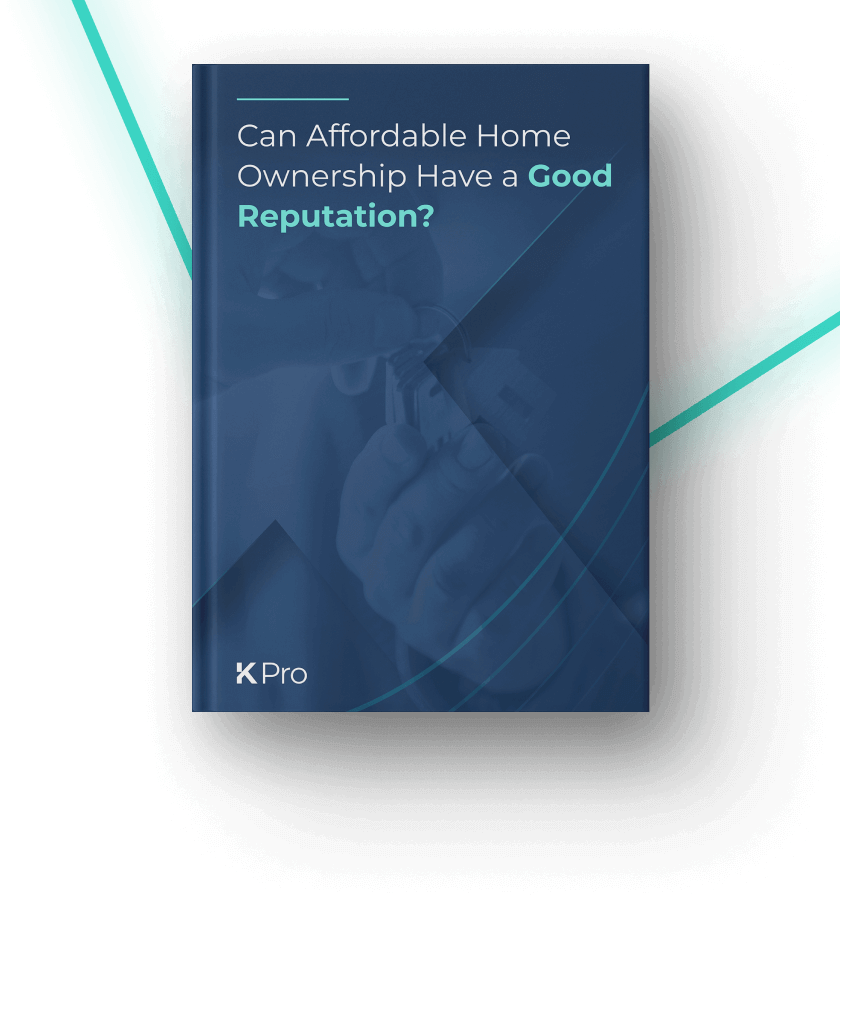
How to Streamline the Affordable Home Ownership Sales Process
Selling an affordable home isn’t just about connecting properties with customers. It starts there, but then often ends up bogged down with eligibility checks, reporting criteria, managing listing requirements and staying in contact with customers.
All of these unique factors mean that affordable housing providers struggle to use commercial estate agency software to get the job done. Unfortunately, this reality often results in a slow, disjointed and inefficient process, filled with manual steps and procedures.
At KPro, we’ve witnessed these difficulties first-hand. Our system started as a back-end integration to help affordable home ownership providers access customers through Keaze. We are now bringing this solution to the wider market.
This article will explore how affordable housing software is changing the affordable home ownership sales process, and the impact of this transformation on each step of the sales pipeline. This includes a smoother and more personalised customer experience, better planning, increased automation and improved outcomes at lower cost. Let’s get started.
Suggested reading: If you want to learn more about the impact of digital transformation on the affordable housing sales process, check out our new eBook — Can Affordable Home Ownership Have a Good Reputation?

Step 1: One-click listings across all platforms
For customers, online listing sites have transformed house hunting for the better. For providers, these platforms increase your reach and ability to get in front of the right people. However, they also generate a distinct set of challenges:
- Creating every listing: Each listing needs to be built for each site. Ideally, this should be automated. However, if it’s not, simply getting your properties on all relevant sites (including your own site) can be very time consuming, much less ensuring consistency across listings.
- Updating listings: When a property sells, or any change is made to that listing, those updates need to be applied across all listing sites. Without automation, this is time-consuming and information can easily get out of date — even resulting in you leaving properties listed that have been sold.
Listing sites dedicated to affordable home ownership amplify both the benefits and challenges. They create a hyper-specific audience that you need to connect with. However, these platforms also often have unique requirements and processes for listing properties, related to the complexity of shared ownership, shared equity and Help-to-Buy schemes, that are not supported by standard estate agency software. This severely limits options when it comes to automating listings.
Strategies for success:
The only efficient and easy way to avoid manual process and allow for one-click listings is to use sales and letting software built for affordable home ownership, or build that software yourself. You need a tool that’s able to use a single listing template, and then upload that onto all relevant sites. In addition to standard property information, you need a tool able to list:
- Tenure type
- Minimum share percentage
- Staircasing projections
- Affordability criteria
- Prioritisation and eligibility criteria
This tool then needs to support the standard API integrations required to integrate with listing sites and your own internal database (if applicable). However, it’s the specific listing criteria that is, generally, unique to this market.
Step 2: Centralise leads and information
When listings across multiple sites, you’re (hopefully) going to get leads from multiple sites. However, you’ve probably experienced the time waste of having to go into each site to pull out your lead information. Effectively, this is the flip side of the first problem, and it’s maybe even more important to change.
Time gets wasted collating and standardising the information in a centralised place. We all know that such spreadsheets become monsters, with old data not being removed and new information potentially getting inputted incorrectly. Over the long term, things can get worse and worse. Alternatively, the information doesn’t get centralised at all (hands up if this sometimes happens in your office!), and leads end up sitting in different places while your team tries to follow up on them.
Ultimately, if you have to manually sift through leads, not only is time wasted, information is lost and it’s not possible to follow up with hot leads quickly.
Strategies for success:
A lead management tool can centralise your incoming lead information and present it in a way that helps (rather than inconveniences) your sales team as they move through each step of the sales process. Of course, your lead management tool needs to be able to:
- Interface and integrate fully and automatically with all the property platforms. (that is to say, API compatible, with RestAPI and BulkAPI capabilities)
- Support the complicated shared ownership contracts & affordable ownership information fields such as “help-to-buy”, ownership percentages, etc
- Provide management functions such as grouping leads together, allocating groups to colleagues, and updating the data as progress occurs.
Again, the complexity of affordable home ownership listings makes it difficult to use standard real estate lead management software. Additionally, the tool you use needs to provide automated email/remarketing functions. If it doesn’t, it needs to seamlessly integrate with a CRM that can. More on that later.
Step 3: Provide self-service information
Providing sales prospects with self-service information does two things:
- It frees up time for your sales team that would be waisted providing information customers can get themselves
- On-demand access to information empowers customers by providing them with the information they need when they want it.
Buying a house isn’t a self-service process. But booking a viewing, checking floor plans or requesting boiler repair information all can be. Fundamentally, customers want self-service options. In fact, 88% of customers expect companies to have a self-service support portal.1 The popularity of self-service listing sites, where home seekers can look for and compare houses in their own time, emphasise this point within the specific context of affordable home ownership.
Strategies for success:
Providing your customers with a tool or interface that allows them to receive and view personalised information and updates on their progress can be invaluable. This is exactly why we built the Customer Portal for KPro. This dedicated portal allows customers to manage their:
- “Favourite” listings and properties
- Viewings and appointments
- Application form
- Documentation status and requirements
- ID verifications
- Sales milestone tracker
- Moving in arrangements
This provision can continue into the longer term, with the Home User Guide or Customer Portal for Residents providing critical information automatically to customers. Again, this can be especially important for shared ownership, allowing people to check their rent and service charge accounts as well as manage their equity percentage and staircasing ambitions.
Empower home seekers and owners with their very own customer portal.
Step 4: Automate paperwork
You probably don’t need any persuading on how helpful automating paperwork could be. However, we need to be aware that this specific industry has specific and unique requirements.
Suppose your workflows in this industry are switching to digital, with one-click online listings, automated lead centralisation, automated outreach, and response. In that case, you will already have a great deal of customer & property information collated and aligned when the cycle reaches one of the paperwork stages.
The good news is that automation goes beyond marketing, outreach, and collection. It should be possible to set up conditional and personalised automation for specific and unique parts of the affordable home ownership sales process. This can help manage and mitigate pain points for your sales reps.
Strategies for success:
You may already be using a CRM system that can help you automate or manage responses to property information requests, viewing reminders/instructions, follow-up messages, marketing emails pulling previous leads into new developments, current tenant check-ins, etc. However, for this to work, you need to make sure that your CRM can integrate with the tool you are using to manage listings and centralise leads. You also need additional, industry-specific capabilities. Ideally, your tool needs to be able to automate:
- Assessment forms and purchase documents
- Industry-specific requirements such as CORE (COntinuous REcording) reporting
- e-Sign documentation for shared ownership agreements
KPro was designed to handle these unique requirements, either as a standalone system or by acting as a modular plug-in to an existing CRM. It can then integrate your entire system with your wider listing and lead management capabilities, making that overall solution the best CRM for affordable housing.

Technology helps you focus on people and the big picture
Finding and deploying the right tool is key to streamlining your sales process. As you know, the affordable home ownership sales process includes some unique features. This, in turn, means that many of the “usual” and more general tools are not totally fit for purpose.
Yet, if you can find a solution that unlocks these potentials, you can free up time to focus back on people and deliver much better experiences to your customers. The increased efficiencies such a smooth process allows also equate to savings that you can then use in other areas.
Further, a properly integrated centralised information store unlocks powerful analytic potentials. Analysing a holistic set of data can give you insights that are valuable for other areas of your business. We’ve already mentioned the potential for remarketing above, but analytics could also help you project how quickly housing stock might fill up when planning developments & financing, for example.
Kpro was purpose-built for the unique requirements and conditions of this affordable home market. It provides a suite of innovative features, including:
- One-click-listings
- Lead centralisation
- Lead automation
- Process automation
- Reports and analytics
- Customer (self-service) portal
- Home user (self-service) guide
Book a free demo today and see how KPro can boost your sales and efficiency.
1 Customers: opinion on self-service portal usage by brands 2018 | Statista
About The Author
Nick has been active in the property sector for the last 12 years working previously in finance. He is a system architect and business owner and has worked with many of the G15 providers to consult in harnessing technology to provide solutions to daily tasks.







